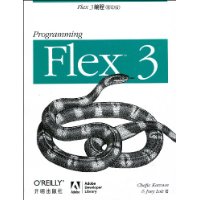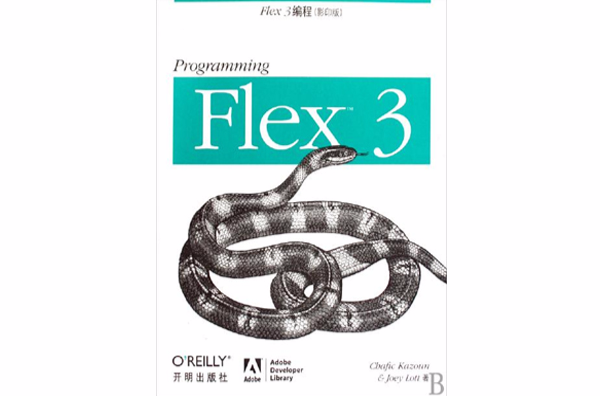《Flex3編程》是2009年開明出版社出版的圖書,作者是CbaficKazoun JoeyLott。
基本介紹
- 書名:Flex3編程
- 作者:CbaficKazoun JoeyLott
- ISBN:9787802057371
- 定價:82.00 元
- 出版社:開明出版社
- 出版時間: 2009年04月
- 開本: 16開
內容簡介,作者簡介,圖書目錄,
內容簡介
《Flex 3編程》為幫助你理解Flex 3核心概念打下堅實的基礎,並對如何、為何以及何時使用Flex的特定功能提供有價值的見解。難以計數的例子和實例代碼演示了使用免費Flex開發工具包來構建完整實用的網路應用程式的方法。本書是Adobe公司的Flex 3參考文檔的絕妙伴侶書。
作者簡介
Chafic Kazoun是Atellis的創始人之一和首席軟體架構師。從1998年開始他就使用Flash技術,並且在Flex面世伊始就開始使用這項技術。.

Joey Lott是Morphic Group的創辦合伙人之一,該公司的專業領域就是Flex應用程式開發。Joey也寫了很多其他關於Flex和Flash相關技術的主要書籍,包括O?Reilly的《ActionScript 3.0 Cookbook》。
圖書目錄
Foreword
Preface
1Introducing Flex
Understanding Flex Application Technologies
Using Flex Elements
Working with Data Services (Loading Data at Runtime)
The Differences Between Traditional and Flex Web Applicanons
Understanding How Flex Applications Work
Understanding Flex and Flash Authoring
What's New in Flex 3
2Building Applications with the Flex Framework
Using Flex Tool Sets
Creating Projects
Building Applications
Deploying Applications
3MXML
Understanding MXML Syntax and Structure
Making MXML Interactive
4ActionScript
Using ActionScript
MXML and ActionScript Correlations
Understanding ActionScript Syntax
Variables and Properties
Inheritance
Interfaces
Handling Events
Error Handling
Using XML
Reflection
5Framework Fundamentals
Understanding How Flex Applications Are Structured
Loading and Initializing Flex Applications
Understanding the Component Life Cycles
Loading One Flex Application into Another Flex Application
Differentiating Between Flash Player and the Flex Framework
Caching the Framework
Understanding Application Domains
Localization
6Managing Layout
Flex Layout Overview
Making Fluid Interfaces
Putting It All Together
7Working with UI Components
Understanding UI Components
Buttons
Value Selectors
Text Components
List-Based Controls
Pop-Up Controls
Navigators
Control Bars
8Customizing Application Appearance
Using Styles
Skinning Components
Customizing the Preloader
Themes
Runtime CSS
9 Application Components
The Importance of Application Components
MXML Component Basics
Component Styles
10Framework Utilities and Advanced Component Concepts
Tool Tips
Pop Ups
Cursor Management
Drag-and-Drop
Customizing List-Based Controls
Focus Management and Keyboard Control
11 Working with Media
Overview
Adding Media
Working with the Different Media Types
12 Managing State
Creating States
Applying States
Defining States Based on Existing States
Adding and Removing Components
Setting Properties
Setting Styles
Setting Event Handlers
Using ActionScript to Define States
Managing Object Creation Policies (Preloading Objects)
Handling State Events
Understanding State Life Cycles
When to Use States
13 Using Effects and Transitions
Using Effects
Creating Custom Effects
Using Transitions
Creating Custom Transitions
14 Working with Data
Using Data Models
Data Binding
Enabling Data Binding for Custom Classes
Data Binding Examples
Building Data Binding Proxies
15Validating and Formatting Data
Validating User Input
16Client Data Communication
Local Connections
Persistent Data
Communicating with the Host Application
17Remote Data Communication
Understanding Strategies for Data Communication
Working with Request/Response Data Communication
Web Services
Real-Time/Socket Connection
File Upload/Download
18 Application Oebugging
The Flash Debug Player
Using FDB
Debugging with Flex Builder
Remote Debugging
Logging Using trace() Within an Application
The Logging Framework
Debugging Remote Data
19 Building Custom Components
Component Framework Overview
Component Life Cycle
Component Implementation
Adding Custom Properties and Events
Adding Styling Support
20 Embedding Flex Applications in a Web Browser
Embedding a Flex Application in HTML
Integrating with Browser Buttons and Deep Linking
Flash Player Security
Using Runtime Shared Libraries
21 Building AIR Applications
22 Building a Flex Application
……

